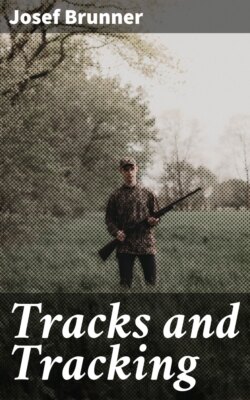Читать книгу Tracks and Tracking - Josef Brunner - Страница 3
На сайте Литреса книга снята с продажи.
FOREWORD
ОглавлениеTable of Contents
TO derive the greatest pleasure from the pursuit of game, either large or small, it is necessary that the disciple of Nimrod be versed in the science of interpreting the meaning of tracks and trails. Nature is as an open book to the man who can read the signs of the woods and plains correctly; and where the uninitiated see only meaningless tracks, experienced hunters find them in many instances the guide to exhilarating sport and a desired trophy. To the tyro the finest tracking snow is useless and the marks he sees everywhere around him simply bewilder him. Were he able to read them as every hunter should, his day's sport would mean enjoyment and success, instead of disappointment and failure.
Game is not so plentiful as it used to be, and for this reason it is generally a waste of time—from the standpoint of the game bag—merely to tramp through the woods and trust to luck. Moreover, the high-power, small-caliber rifles, which are so extensively used, very often lead to shots at distances at which it is not possible to place an immediately fatal bullet. This makes it the more necessary for the hunter to be able to read the signs correctly and to interpret aright the language of the trails. Every sportsman should consider it a sacred duty to bring to bay any animal he has wounded, and he should also regard it a matter of honor to acquire a working knowledge of tracks, trails, and signs. Then he will not, through ignorance, make carrion or wolf-bait of a noble creature which, in all reason, he should have secured.
A sportsman who is unable to interpret the meaning of tracks he encounters, however much game he may have killed by chance, luck, or with the assistance of others, will be considered a tyro in woodcraft by companions who have learned their lessons in this art.
Lack of opportunity on the part of the majority of sportsmen to become versed in tracking lore by actual experience, as well as the incompetence of a great number of guides, is the reason for this book. The contents represent the experience gained from twenty years of uninterrupted life in the great outdoors; and while only half of that time was spent in the pursuit and study of American game, the foreign experience was a considerable aid in arriving at definite conclusions, for the same species, with but few exceptions, show the same features in their trails the world over.
No space has been given to microscopic intricacies, since in the woods plain tracking lore is intricate enough. In practice whoever looks for exaggerated, fine, distinctive features in tracks and trails soon sees things which a sober-minded expert recognizes as imaginative.
It is generally understood that a track means the imprint left on the ground or snow by a passing creature. From its form and appearance the initiated are usually able to tell the species, and in some cases the variety, of animal that made it. Where the latter is not possible, a succession of tracks—the trail, in short—is almost invariably the means of reaching a proper decision. The expert considers not only tracks and trails, but also the "signs," among which are the behavior of animals under certain circumstances, blazed trees, bear logs, beaver stumps and cuttings, excrements, etc., etc. A mere treatise of tracks, trails and signs would in many instances leave the inexperienced man without a comprehensive knowledge; therefore certain actions of the hunted, and notes on hunting methods which have proved practical, although they are not generally known, have been introduced into the text.
It is believed that a thorough study of this book, including the illustrations, will enable the reader to become as well versed in tracking lore as he could by years of actual experience in the woods.
TRACKS AND TRACKING
